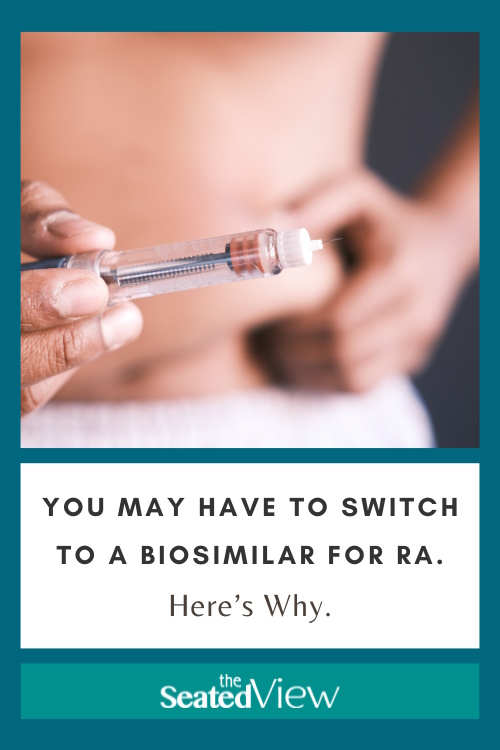You May Have to Switch to a Biosimilar for Rheumatoid Arthritis. Here’s Why.

In March 2023, I received a letter from the Ontario government. It informed me that a biosimilar switching policy was now in place. People like me who receive funding from the government to pay for Biologics for rheumatoid arthritis (RA), Crohn’s disease, and other forms of autoimmune disease were given until the end of 2023 to make the switch. This change in policy is happening in many areas, including the US, and it’s making many of people who take Biologics very nervous. This is the first post in a series about my own experience switching to a biosimilar but before we get to that, let’s look at some basic facts about this kind of medication.
Read Part Two of my Biosimilar series: My Experience as an ‘Outlier’ Trying (So Far) 3 Biosimilars
What Are Biosimilars and Why Do You Have to Switch?
When a pharmaceutical company develops a new drug, it has a patent for a certain number of years. When that patent expires, other companies may create generic versions of these drugs. In small molecule drugs, such as painkillers, proton pump inhibitors (medications for acid reflux), or blood pressure medication, these generic drugs contain an identical medication, with an addition of non-medical substances, such as binders to make the tablet stick together, that may be different from the original drug. Many of us take these generic medications every day and do well on them.
Biologics, on the other hand, are large molecule drugs and cannot be duplicated exactly. Biosimilars are medications that are highly similar to what’s called the reference biologic (the original medication) and, according to the US Food and Drug Administration (FDA), “must have no clinically meaningful differences from their original biologic.” It must also have the same strength and dosage, be administered the same way, have the same potential side effects, and be as effective as the reference biologic. Any biosimilar on the market has been studied extensively to show that it meets these requirements.
Since Biologics are made from living cells, they also change over time and no batch of a biologic will be identical. Rick Phillips, RA and diabetes advocate who advocates for the use of biosimilars, told me in an email interview that “like making yeast dough, it depends on the microorganisms and how they digest the sugars, proteins, nucleic acids, or complex combinations of these substances … Since they are not the same, the results will be slightly different.”
That means that the injections of my biologic I have taken over the year have essentially been biosimilars of itself. In the US, that’s also called a bioequivalent, a drug that is so near the original that pharmacists do not need to tell us there is a difference and may in fact dispense instead of (for instance) the biologic on your prescription. You may already have experienced us.
Thanks to Rick for sharing an email with this clear explanation which did much to help me approach the switch with optimism.

Biosimilars in Europe and Now in Canada.
Biosimilars are not a new treatment. In fact, biosimilars have been used in Europe for a decade and have been working well for the autoimmune disease community and the field of rheumatology in that area. In fact, 92% of European clinicians prescribe biosimilars to approximately 25% of their RA patients. It’s clear that in the European Union, biosimilars are a well-established treatment for autoimmune arthritis and other conditions for which biological medications have been developed. And this has saved a lot of money. Biologics are expensive, both for the programs that pay for them, as well as for those who need to pay a deductible or a co-pay. In Europe, a white paper by IQVIA commissioned by the European Union estimated that as of 2022, the cumulative savings attributed to the presence of biosimilars in that market was over €30 billion.
However, North America has been slow to introduce biosimilars. Extended North American patents had delayed the process but now that these are expired, more funders have implemented biosimilar switching policies and we can expect others will do so in the near future. Last year, Ontario became the 8th province or territory in Canada to implement this kind of policy and the remaining four are working on theirs. The main reason behind these policies is to save money.
And really, I get it. The difference was made abundantly clear to me when I picked up my first package of a biosimilar and compared the price paid by the Trillium Drug Program for my biologic. The biosimilar was one third of the price of the biologic, that is, it cost $1,300 instead of $3,300.
The evidence is incontrovertible. Paying for a biosimilar will save two thirds of the costs associated with my treatment. Well, for the government, that it is. My deductible will remain the same, because even though the biosimilar is less expensive than the biologic, it is still very expensive.
Since I first started Biologics, I’ve been very aware that this medication that enables me to live my life is paid for by taxes paid by the citizens of Ontario. From the very beginning, I have been grateful every time I take this injection. I understand and support that governments need to be careful with those funds. There may even be benefits to the chronic illness community in these savings; hopefully more people will be able to get qualify for the treatment that can make them healthier. But even so, there is a human cost to this switch.
The Human Cost of Biosimilars Savings
Switching a medication that works to something else for a non-medical reason is frustrating and scary. It’s one thing to switch if you have horrible side effects or the drug is working as it should, but being forced to abandon a medication that has worked well for you — in my case, for 17 years — well… That’s where it gets scary.
When your chronic illness is active, it hits all of your life and everything you do. Uncontrolled rheumatoid arthritis affects your ability to work, to take care of your family, to get out of bed in the morning, or whether you can make a sandwich. Finding a medication that controls your condition can feel like a miracle — and to me, it did. Still does. Certain chronic illness organizations advocated in that the switching policy would make an exception for those who were stable on their existing biologic, but unfortunately, this was not included in the final policy. Personally, I was very anxious about switching.
Read more about the potential impacts of the biosimilars switch in my article for CreakyJoints Canada.
But, I work on the basis of evidence and all the evidence indicates that this would be okay. My rheumatologist told me that all of her other patients who took Biologics had switched with no problems. My conversation with Rick lead to a deeper understanding of Biologics essentially being bioequivalent of themselves — which explains why my side effects sometimes differ from dose to dose. I have done a lot of reading about biosimilars and even quite a bit of writing. Everything points to this being a non-problem. Who knows, I said to myself on a sunny day in August when I picked up my biosimilar prescription, this might even reduce my side effects…
Stay tuned for Part Two in this series to read about my experience with switching to a biosimilar.
Sources:
Health Canada. “Government of Canada.” Canada.ca, August 27, 2019. https://www.canada.ca/en/health-canada/services/drugs-health-products/biologics-radiopharmaceuticals-genetic-therapies/applications-submissions/guidance-documents/fact-sheet-biosimilars.html#a2.
Chambers, James D., Rachel C. Lai, Nikoletta M. Margaretos, Ari D. Panzer, Joshua T. Cohen, and Peter J. Neumann. “Coverage for Biosimilars vs Reference Products among US Commercial Health Plans.” JAMA 323, no. 19 (May 19, 2020): 1972. https://doi.org/10.1001/jama.2020.2229.
Office of the Commissioner. “Biosimilars Are as Safe and Effective as the Original Biologic.” U.S. Food and Drug Administration, August 17, 2023. https://www.fda.gov/consumers/consumer-updates/biosimilar-and-interchangeable-biologics-more-treatment-choices.
“How the U.S. Compares to Europe on Biosimilar Approvals and Products in the Pipeline Updated March 14, 2022.” JD Supra, March 14, 2022. https://www.jdsupra.com/legalnews/how-the-u-s-compares-to-europe-on-7635750/.
“The impact of biosimilar competition in Europe.” December, 2022. https://www.iqvia.com/-/media/iqvia/pdfs/library/white-papers/the-impact-of-biosimilar-competition-in-europe-2022.pdf.
Pine, Lana. “Breaking down Barriers: Why Biosimilars Face Resistance in the US Market.” HCP Live, December 18, 2023. https://www.hcplive.com/view/breaking-down-barriers-why-biosimilars-face-resistance-us-market.
“Rheumatologists Are Prescribing More Biosimilars.” GaBi Online, May 31, 2021. https://www.gabionline.net/reports/rheumatologists-are-prescribing-more-biosimilars.
Read More
Discover what else I've been writing about...















